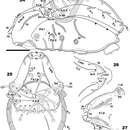Description
provided by Zookeys
301 μm × 198 μm.
Shape: ovoid (Figure 25).
Colour: Yellow to light brown; slightly shiny, when observed in reflected light.
Cerotegument. Not observed.
Integument. Notogaster and prodorsum smooth; anterior zone of lam and lateral body zone with small protuberances (Figures 24, 25, 27).
Prodorsum. Triangular to slightly polyhedral (dorsal view) (Figures 25, 27); curving in lateral view (Figure 24). Complete e.i.p (Figures 24, 25).
Posterior prodorsal depression (p.p.d) absent (Figures 24, 25). Setae in, medium length, situated on e.i.p, similar to long simple notogastral setae situated adjacent to and inside n.a.d, in all cases in setae directing backward and entangled with the cited notogastral setae (Figures 24, 25 ).
Three pairs of prodorsal setae (in, ro, le) (Figures 24–27), very different in shape and length: in> le> ro; ro setae small, phylliform, slightly barbate, directing forward; in setae inserted on e.i.p antiaxially to medial plane and slightly externally to ro insertion level, close to l.l.f; directing posteriorly, exceeding the prodorsal margin, extendingto n.a.d; le setae sausage-shaped, slightly barbate, observation difficult (depending on position/angle of observation), laterally situated on lamellar apical zone, but far from la.ti, directing forward. Rostral margin rounded to polyhedral (Figures 25, 26).
Lamellae running laterally; l.l.f well discernible (Figures 25, 26, 27); la.ti rounded to polyhedral. Superior cornea of naso (cso) clearly visible as convex elevation situated anterior to ro setae insertion level (Figures 26); upward curving sensillus (si), uncinate with small barbs (Figure 27).
Round-ovoid Bo with longitudinal ridges; bo.ri smooth, clearly visible bo.to (Figure 24).
Notogaster. Dorsal view: ovoid with polyhedral anterior zone of h.ap. (Figure 25). Lateral view, anterior part (zone of n.a.d) depressed, concave and rest convex (Figure 24); h.ap prominent expansion, large rounded tip (Figures 26, 27).
Notogaster smooth (Figure 25). Anterior notogastral depression (n.a.d) easily discernible, conspicuous, large, extending forward, ovoid anterior zone, polyhedral posterior border (Figure 25).
Circumgastric depression (s.c) present, hardly discernible, situated paraxially to lateral notogastral setal insertion (p1, p2, p3, h3).
Fourteen pairs of notogastral setae, two pairs situated posterior to n.a.d, one far from posterior border of n.a.d; both pairs directing forward, not exceeding d.sj; four pairs inside n.a.d, three pairs situated near d.sj extending backward or laterally (indicated in Figure 25 with X); fourth pair situated far from d.sj, extending forward or laterally, not exceeding d.sj (indicated in Figure 25 withJ); four pairs situated marginally to n.a.d, extending forward; four pairs, situated marginally to notogaster, directing backward, these four pairs are possibly named as h3, p1, p2, p3 (Figure 25).
Lyrifissures difficult to observe; two pairs present, first pair situated at level of h3 setae, the other situated between p3 and p2 (Figure 24).
Humeral apophysis (h.ap) clearly discernible (Figures 24, 25). Posterior bothridial zone overlapping anterior tip of h.ap (Figures 24, 25).
Remarkable border tectum, not prolonged by a limbus, space existing between the notogastral and ventral figs (Figures 24, indicated by arrows ·).
Lateral region. Tutorium (tu) clearly visible as a strongly curving cuticular thickening. Between lamellae and tutorium, deep supratutorial depression (s.tu.d) running parallel to both structures (Figure 24). Bothridia cup-shaped with smooth bothridial ring (bo. ri); bo.ri incomplete with bo.to clearly visible (Figures 24); si uncinate with small barbs, curving upward (Figure 27, pointed tip).
Lamellae with la.ti, round-polyhedral (Figures 26, 27); le setae sausage-shaped, rough-barbate surface, viewing angle slightly changing observation (see both sides of drawing Figure 27); ro small, philliform, barbate (Figures 26, 27); n.a.d clearly discernible; d.sj hardly visible. Lateral view greatly assists in understanding of different setae directions, and perceiving complexity found at n.a.d level (Figure 24).
Pedotectum I, prominent extended lamina, rounded apex. Pedotectum II, small polyhedral lamina, rounded edges. Humeral apophysis triangular; basally slightly convex and immediately concave; anterior tip overlapping posterior bothridial zone (Figure 24).
Only two pairs of lyrifissures visible at level of h3 setae and between p3 and p2. Discidium not discernible. Sejugal zone depressed. Semicircular ridges at level of acetabulum IV (Figure 24).
Ventral region. Well described by Mahunka (2000: page 89 and Figure 6) only adding: the a.g.d is clearly visible.
- license
- cc-by-3.0
- copyright
- Nestor Fernandez, Pieter Theron, Christine Rollard, Elio Rodrigo Castillo
- bibliographic citation
- Fernandez N, Theron P, Rollard C, Castillo E (2014) Revision of the family Carabodidae (Acari, Oribatida) VII. Redefinition of the genus Malgasodes; redescription of M. curvisetus Mahunka, 2000; and complementary description of M. hungarorum Mahunka, 2010. Phylogenetic relationships between Malgasodes, Bovicarabodes, Afticarabodes, Congocepheus and Cavaecarabodes are discussed ZooKeys 435: 25–48
- author
- Nestor Fernandez
- author
- Pieter Theron
- author
- Christine Rollard
- author
- Elio Rodrigo Castillo
Distribution
provided by Zookeys
Paratype: Madagascar, Tomasina Province, Mananara Nord Biosphere Reserve and National Park, Lowland rainforest, NW slope Behafotra Hill; 250–300 m alt. 16°27. 1–3'S, 49°47.6'E.14–15 August 1988. N° 9877. Leg. T. Pócs. Deposited in the Museum of Natural History, Geneva (MNHG).
- license
- cc-by-3.0
- copyright
- Nestor Fernandez, Pieter Theron, Christine Rollard, Elio Rodrigo Castillo
- bibliographic citation
- Fernandez N, Theron P, Rollard C, Castillo E (2014) Revision of the family Carabodidae (Acari, Oribatida) VII. Redefinition of the genus Malgasodes; redescription of M. curvisetus Mahunka, 2000; and complementary description of M. hungarorum Mahunka, 2010. Phylogenetic relationships between Malgasodes, Bovicarabodes, Afticarabodes, Congocepheus and Cavaecarabodes are discussed ZooKeys 435: 25–48
- author
- Nestor Fernandez
- author
- Pieter Theron
- author
- Christine Rollard
- author
- Elio Rodrigo Castillo

